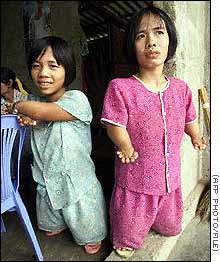Case Studies In The Human Development That Is Lost During Time Of Warfare
"For a stark reminder of the Vietnam War, people living near the airport in this central industrial city can still stroll along the old stone walls that once surrounded a U.S. military base. But Luu Thi Nguyen, a 31-year-old homemaker, needs only to look into the face of her young daughter.
Van, 5, spends her days at home, playing by herself on the concrete floor because local school officials say her appearance frightens other children. She has an oversize head and a severely deformed mouth, and her upper body is covered in a rash so severe her skin appears to have been boiled. According to Vietnamese medical authorities, she is part of a new generation of Agent Orange victims, forever scarred by the U.S.-made herbicide containing dioxin, one of the world's most toxic pollutants.
For decades, the United States and Vietnam have wrangled over the question of responsibility for the U.S. military's deployment of Agent Orange. But officials say they are now moving to jointly address at least one important aspect of the spraying's aftermath -- environmental damage at Vietnamese "hot spots" such as Nguyen's city, Da Nang -- that are still contaminated with dioxin 31 years after the fall of Saigon.
Though neither Nguyen nor her husband was exposed to the Agent Orange sprayed by U.S. forces from 1962 to 1971, officials here say they believe the couple genetically passed on dioxin's side effects after eating fish from contaminated canals. "I am not interested in blaming anyone at this point," the soft-spoken Nguyen said on a recent day, stroking her daughter's face. "But the contamination should not keep doing this to our children. It must be cleaned up."
Vietnamese and U.S. officials last year conducted their first joint scientific research project related to Agent Orange. Testing of the soil near Da Nang's airport, where farmers say they have been unable to grow rice or fruit trees for decades, showed dioxin levels there as much as 100 times above acceptable international standards." ...
Anthony Faiola "In Vietnam, Old Foes Take Aim at War's Toxic Legacy" Washington Post November 13, 2006
http://www.washingtonpost.com/wp-dyn/
content/article/2006/11/12/AR2006111201065.html

Human young adult victims of the American Agent Orange poisoning of the Vietnamese ecosystem.
Photo credit: (c) Agence France Presse archives. With thanks.
Van, 5, spends her days at home, playing by herself on the concrete floor because local school officials say her appearance frightens other children. She has an oversize head and a severely deformed mouth, and her upper body is covered in a rash so severe her skin appears to have been boiled. According to Vietnamese medical authorities, she is part of a new generation of Agent Orange victims, forever scarred by the U.S.-made herbicide containing dioxin, one of the world's most toxic pollutants.
For decades, the United States and Vietnam have wrangled over the question of responsibility for the U.S. military's deployment of Agent Orange. But officials say they are now moving to jointly address at least one important aspect of the spraying's aftermath -- environmental damage at Vietnamese "hot spots" such as Nguyen's city, Da Nang -- that are still contaminated with dioxin 31 years after the fall of Saigon.
Though neither Nguyen nor her husband was exposed to the Agent Orange sprayed by U.S. forces from 1962 to 1971, officials here say they believe the couple genetically passed on dioxin's side effects after eating fish from contaminated canals. "I am not interested in blaming anyone at this point," the soft-spoken Nguyen said on a recent day, stroking her daughter's face. "But the contamination should not keep doing this to our children. It must be cleaned up."
Vietnamese and U.S. officials last year conducted their first joint scientific research project related to Agent Orange. Testing of the soil near Da Nang's airport, where farmers say they have been unable to grow rice or fruit trees for decades, showed dioxin levels there as much as 100 times above acceptable international standards." ...
Anthony Faiola "In Vietnam, Old Foes Take Aim at War's Toxic Legacy" Washington Post November 13, 2006
http://www.washingtonpost.com/wp-dyn/
content/article/2006/11/12/AR2006111201065.html

Human young adult victims of the American Agent Orange poisoning of the Vietnamese ecosystem.
Photo credit: (c) Agence France Presse archives. With thanks.


0 Comments:
Post a Comment
<< Home